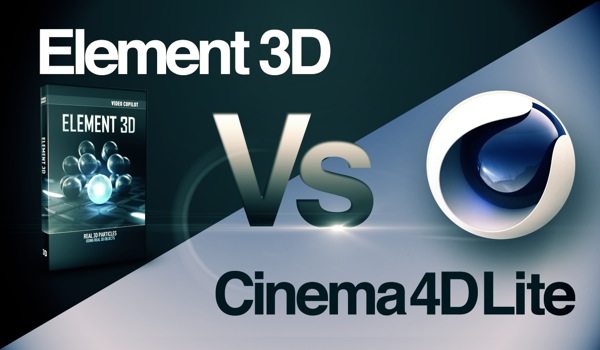The inclusion of Cinema 4D Lite in the latest version of After Effects, has got a lot of artists wondering if they need Video Copilot’s Element 3D as well for 3D work in After Effects. The simple answer is that both pieces of software have their advantages and disadvantages and that a lot can be gained by having both in your AE toolbox.
Unlike other AE plug-ins, Element 3D is very inexpensive, you can pick it up for $149.95 or even cheaper here. Cinema 4D Lite comes free with After Effects if you’ve got an Adobe Creative Cloud subscription. So unless money is really tight, having both plugins available for your projects should be a real possibility. That being said, what are some of the advantages of each plugin? Read on…
Modelling
Unlike most other 3D programs, neither Cinema 4D Lite or Element 3D have polygonal modelling tools. This means editing the mesh of a model isn’t currently an option. If you want to be able to create and edit your own 3D models in After Effects beyond simple primitives, text and mask extrusion, you’ll need something more powerful such as either the Broadcast or the Studio version of Cinema 4D.
Render Speed
This is where Element 3D really excels. Element 3D renders using your GPU, allowing it to render 3D objects in almost real-time in After Effects. Depending on how powerful your graphics card is, you can render a huge amount of polygons and detailed textures in minutes with Element 3D, that would take hours with the Cinema 4D Lite renderer. This means that experimenting with different looks and settings in your AE project is easy to do with Element 3D as you’re getting instant feedback as you make changes. This gives you a lot of freedom and helps speed up revisions if you’ve got fussy clients – saving you time and money. Element 3D also has it’s own Depth of Field rendering system, which gives you the option of making your renders look more cinematic, without having to worry about long render times.
Render Quality
Cinema 4D Lite might not have the fastest renderer but it definitely has the most accurate and photo-realistic results. Because Cinema 4D Lite produces ray traced renders using your CPU, it is more physically accurate. This means that your renders have realistic shadows and reflections, neither of which Element 3D is capable of at the moment. Element does a good job at faking reflections, but it still can’t create reflections of objects within objects in the scene.
Animation
Both programs are capable of basic keyframe animation of the 3D objects such as scale, rotation and position. However, both have their own separate animation systems, which are very powerful. Element 3D has the Animation Engine, which can produce amazing results. It works by morphing two groups of 3D models (or particle systems of those models), to produce a unique and complex looking animation. There are a number of parameters which you can tweak to get completely different results and give your projects a unique look.
Cinema 4D Lite has its MoGraph animation system, which is used by a huge number of motion graphics artists around the world. Cinema 4D MoGraph makes it very easy to create complex looking animations with only a couple of keyframes. It does this through the use of Effectors and objects such as the Cloner or Fracture object. Cinema 4D Lite comes with a couple of these objects and effectors, when you register the software. To get the most out of MoGraph you’ll need to upgrade to either the Cinema 4D Broadcast or Studio version.
Conclusion
Like I said in the introduction, both Cinema 4D Lite and Element 3D have a number of advantages and disadvantages, they are ‘complimentary’ rather than ‘either/or’. As a motion graphics or VFX artist it’s down to you to pick the best tool depending on what the project requires. For example, if you’re carrying out ‘look development’ for a client who requires a multitude of different options, then Element 3D would be the best choice, due to it’s rendering speed. If however, you need to produce a photo-realistic still, with a high level of detail, shadows and reflections, then Cinema 4D Lite is likely to be your best choice.
As for me, I’m going to be using both. I’m just blown away that we now have access to such fantastic tools within After Effects.

